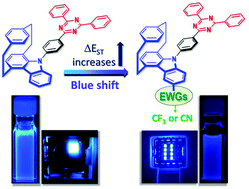Electron-withdrawing group modified carbazolophane donors for deep blue thermally activated delayed fluorescence OLEDs†
Abstract
We report two blue-emitting thermally activated delayed fluorescence (TADF) compounds employing a substituted carbazolophane (Czp) donor (indolo[2.2]paracyclophane). The compounds CNCzpPhTRZ and CF3CzpPhTRZ show emission maxima of 426 nm and 432 nm, respectively, with high photoluminescence quantum yields (ΦPL) of 73% and 80%, respectively. The singlet–triplet energy gap (ΔEST) of both emitters is 0.22 eV, resulting in long-delayed lifetimes of 132 μs for CNCzpPhTRZ and 158 μs for CF3CzpPhTRZ in PPT as the host matrix. Blue organic light-emitting diodes (OLEDs) showed maximum external quantum efficiencies (EQEs) of 7.4% for CNCzpPhTRZ and 11.6% for CF3CzpPhTRZ with electroluminescence maxima of ca. 460 nm.

- This article is part of the themed collection: Popular Advances


 Please wait while we load your content...
Please wait while we load your content...